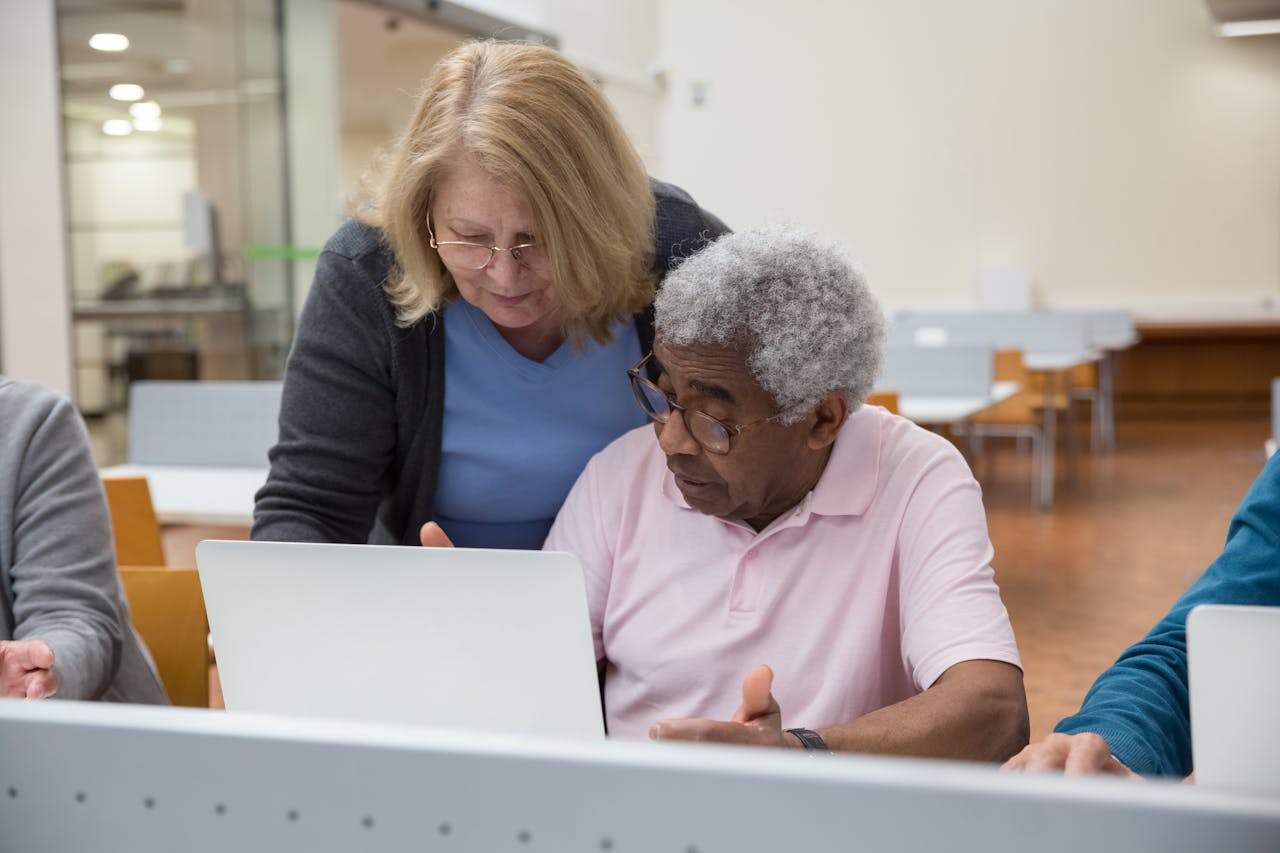Assistive technology (AT) encompasses a broad range of tools and services designed to enhance the quality of life for individuals with disabilities. This technology serves as a critical facilitator, enabling people with disabilities to perform tasks that may otherwise be challenging or impossible, thereby fostering independence and improving overall functionality in daily living. The significance of assistive technology for disabled individuals cannot be overstated, as it plays a pivotal role in their ability to engage with the world around them.
AT can be categorized into several types, including low-tech solutions, such as simple tools and devices, and high-tech innovations, involving advanced technology like software applications and communication devices. Examples of low-tech assistive devices include adapted utensils for eating, wheelchairs for mobility, and magnifying glasses for individuals with visual impairments. On the other hand, high-tech alternatives can include voice recognition software, customized computer accessibility tools, and automated home systems, all tailored to meet the specific needs of users.
Moreover, assistive technology for people with disabilities is not limited to physical adaptations but extends to cognitive and sensory support as well. Tools such as speech-to-text software, auditory alarms, and visual aids contribute significantly to enhancing communication and understanding for individuals facing these challenges. Furthermore, AT services encompass assessments and training to ensure proper usage and integration of these technologies into everyday life.
As we delve deeper into this guide, it becomes evident how assistive technology for disabled individuals is more than just equipment; it is a gateway to independence, education, employment, and social inclusion. Understanding the various forms of assistive technology enables individuals, caregivers, and educators to harness these resources effectively, leading to enriched lives for those living with disabilities.
Types of Assistive Technology
Assistive technology for disabled individuals encompasses a wide range of devices and services designed to enhance the quality of life, enabling them to perform daily activities more independently. This technology can be categorized into several groups, including mobility aids, communication devices, and sensory assistance tools, each catering to specific needs.
Mobility aids are perhaps the most recognizable type of assistive technology for people with disabilities. These devices facilitate movement and physical accessibility. Common examples include wheelchairs, which come in both manual and powered versions, providing users the ability to navigate their surroundings with ease. Walkers and canes are also essential tools that assist those with lower limb disabilities in maintaining stability and independence while walking.
Communication devices represent another significant category of assistive technology. These tools assist individuals with speech or language impairments in expressing themselves. For instance, Augmentative and Alternative Communication (AAC) devices, such as speech-generating devices, enable users to communicate through text or symbols. Apps designed for tablets and smartphones also serve as effective communication aids, allowing for a more flexible and intuitive user experience.
Sensory assistance tools are vital for individuals with sensory disabilities, such as vision or hearing impairments. These include devices like screen readers and magnifiers, which help those with vision impairments access information more effectively. For individuals with hearing loss, hearing aids and assistive listening devices improve the ability to hear and engage in conversations. Other innovative tools, such as captioning apps, provide real-time support during interactions, ensuring inclusivity.
Each category of assistive technology for disabled individuals plays a crucial role in promoting independence and improving daily living experiences. By understanding the different types of assistive devices available, we can better appreciate their impact on enhancing the functional capabilities of people with disabilities.
Benefits of Assistive Technology
Assistive technology for disabled individuals plays a pivotal role in enhancing their quality of life and fostering independence. The widespread use of these technologies has transformed the way people with disabilities engage with their environments and pursue their goals. With the right assistive tools, users can perform daily tasks with greater ease, thus promoting a sense of autonomy that is essential for self-esteem and personal fulfillment.
One of the primary benefits of assistive technology for people with disabilities is the enhancement of communication skills. Devices such as speech-generating software and communication boards allow individuals with speech impairments to express themselves effectively, bridging the gap between them and their peers. This increased communicative capability not only fosters social interactions but also bolsters confidence, enabling users to participate more fully in various aspects of life, including education and employment.
Moreover, assistive technology significantly improves access to education and employment opportunities. For instance, students with visual or hearing impairments can utilize tools like text-to-speech software and captioning services, respectively. Such technologies cater to diverse learning needs, equipping students with equal opportunities to succeed academically. In the workplace, assistive devices such as ergonomic tools and adaptive software facilitate smoother job performance, thereby promoting inclusivity within professional settings.
Real-life testimonials from users provide powerful insight into the profound impact of assistive technology. A recent case study showcased a young woman with mobility challenges who successfully transitioned from high school to university. Her experience underscores how assistive technology for disabled students removed barriers, enabling her to navigate campus and engage in learning just like her peers. Stories like these illustrate the transformative power of assistive technology, not only enhancing individuals’ abilities but also enriching the communities around them.
Assistive Technology in Education
Assistive technology for disabled students has transformed educational settings, providing essential support that fosters inclusive learning environments. These technologies encompass a diverse array of tools designed to assist learners with disabilities in overcoming barriers that might impede their academic success. From simple devices to complex software applications, the incorporation of assistive technology is crucial for enhancing the educational experience of students with disabilities.
In the classroom, commonly employed assistive tools include speech-to-text software, which aids students with writing difficulties by allowing them to dictate their thoughts verbally. Similarly, text-to-speech programs can assist students with visual impairments or reading disabilities by converting written text into spoken words. Furthermore, interactive whiteboards and digital tablets facilitate engagement, enabling students to participate actively in lessons tailored to their learning needs.
The impact of assistive technology on learning outcomes cannot be understated. Research suggests that students with disabilities who utilize assistive tools often demonstrate improved academic performance, enhanced self-esteem, and greater motivation to learn. By level-setting the playing field, these technologies empower disabled students to engage more fully with the curriculum, collaborate with peers, and develop essential academic skills. Educators play a pivotal role in successfully integrating these tools into their pedagogical strategies. Training and professional development enable teachers to better understand the available assistive technologies and how to apply them effectively in their classrooms. This ongoing support ensures that students with disabilities receive tailored instruction that meets their unique learning needs, ultimately leading to more positive educational experiences.
In light of these advancements, it is essential for educational institutions to prioritize the adoption of assistive technology for people with disabilities. By investing in appropriate tools and training, schools can create environments conducive to learning for all students, thereby fostering diversity and inclusion within the educational framework.
Assistive Technology in the Workplace
Assistive technology for disabled individuals plays a crucial role in promoting inclusivity within the workplace. By integrating various tools and resources, organizations can facilitate a work environment that accommodates employees with disabilities, enabling them to perform their job functions efficiently. These adaptations not only enhance productivity but also contribute significantly to employee morale and overall satisfaction.
Adaptations to the workplace can take several forms, ranging from physical modifications to the provision of specialized equipment. For instance, ergonomic furniture can be installed to ensure comfort for individuals with mobility issues, while adjustable desks may assist employees who require standing or sitting options. Furthermore, visual and auditory aids, such as screen magnifiers or text-to-speech software, enable team members with sensory disabilities to navigate their tasks effectively. By incorporating such assistive technology for people with disabilities, workplaces can optimize their functionality and accessibility.
In addition to physical adjustments, it is essential for organizations to foster an inclusive culture that values diversity and promotes understanding. This can include training sessions on disability awareness, which help break down stereotypes and encourage collaboration among all employees. When colleagues are educated about the capabilities and contributions of individuals with disabilities, a more cohesive and supportive work environment can emerge. As a result, the use of assistive technology is not limited to the individual user; its benefits can extend to the entire organization, leading to enhanced teamwork and innovation.
Ultimately, the integration of assistive technology creates a workplace that respects and accommodates the needs of all employees. By embracing these tools and fostering an inclusive culture, organizations can empower individuals with disabilities to achieve their fullest potential, thereby unlocking the diverse talents within their workforce.
Challenges and Barriers to Accessing Assistive Technology
Accessing assistive technology for disabled individuals involves navigating a complex landscape filled with various challenges. One significant barrier is financial constraints. Many assistive devices and services can be prohibitively expensive, leading to difficulties for people with disabilities and their families. Insurance coverage for assistive technology varies widely, and in many cases, it may not cover the costs associated with the necessary equipment or services. Consequently, individuals may find themselves without the essential tools that could enhance their quality of life.
Another challenge is the lack of awareness regarding the available assistive technology for people with disabilities. Many individuals and caregivers may not be fully informed about the options available to them. This can result from insufficient outreach or education from healthcare providers and community organizations. Additionally, some individuals may not realize that certain technologies could significantly improve their daily lives, leading to missed opportunities for empowerment and independence.
Furthermore, the limited availability of devices and services can pose considerable obstacles. In certain regions, especially rural or underfunded areas, there may be fewer resources or specialists knowledgeable about assistive technology. The scarcity of trained professionals who can provide assessments, training, and support further complicates access for those in need. It’s vital that efforts are made to improve the distribution of assistive devices and increase trained personnel in various locations.
In addition to these challenges, advocacy efforts are crucial to combating these barriers. Awareness campaigns that address the importance and availability of assistive technology are essential for reaching potential users. Support from government policies that subsidize costs and enhance training for aid professionals can facilitate broader access. By focusing on these solutions and fostering collaboration among stakeholders, it is possible to make significant strides towards improving access to assistive technology for disabled individuals and empowering them in their daily lives.
Future of Assistive Technology
The future of assistive technology for disabled individuals is poised to witness transformative advancements that can significantly enhance independence and quality of life. One of the most promising areas is the integration of artificial intelligence (AI) into assistive devices. AI can analyze user behavior and preferences, enabling more personalized assistance. For instance, AI-powered communication devices can learn from user interactions, allowing individuals with speech impairments to communicate more effectively by anticipating their needs and preferences.
Wearable technology is another critical trend on the horizon. Devices such as smart glasses, sensors, and health monitors create new possibilities for people with disabilities. These wearables can provide real-time feedback and alerts, such as notifying users of environmental hazards or suggesting mobility adjustments. By harnessing biometric data, wearables enrich the lives of individuals with disabilities, offering insights to improve their health and well-being.
Smart home solutions are also making significant strides in the field of assistive technology for people with disabilities. Home automation systems allow users to control lighting, appliances, and security features through voice commands or mobile applications. This level of control and accessibility empowers those with mobility or cognitive impairments, fostering an environment where they can navigate their homes with ease and autonomy. Furthermore, the IoT (Internet of Things) technology will pave the way for interconnected devices that can communicate with one another, reinforcing the support network for individuals with disabilities.
As these innovations continue to evolve, collaboration among technology developers, healthcare professionals, and advocacy groups will be crucial. By prioritizing user input and focusing on the unique needs and challenges faced by disabled individuals, we can shape a future in which assistive technology becomes more accessible and effective. Embracing these advancements promises to create an inclusive society where every individual, regardless of their disability, can lead an empowered life.
Resources and Support Networks
For individuals seeking to benefit from assistive technology for disabled or people living with disabilities, numerous resources and support networks are available. These organizations provide guidance, funding opportunities, and information to help users navigate the landscape of assistive technology. Here are some valuable resources to consider:
The Assistive Technology Industry Association (ATIA) is an excellent starting point. The ATIA focuses on promoting the benefits of assistive technology for people with disabilities and offers a wide range of resources, including industry news, webinars, and an extensive database of assistive technology products. Their website also provides information on how to connect with professionals in the field.
National Assistive Technology Act Technical Assistance and Training (AT3) is another essential resource. AT3 provides information on state assistive technology programs, helping individuals locate services and products that meet their specific needs. By providing local resources, AT3 simplifies the process of finding assistive technologies tailored to various disabilities.
State-specific Assistive Technology Programs are crucial as well. Each state has designated programs that inform individuals about available resources, funding options, and support networks within their communities. Visiting your state’s assistive technology program page can offer information on loans, grants, and equipment exchanges for assistive technology for disabled individuals.
The American Association of People with Disabilities (AAPD) also plays a significant role by advocating for the rights of individuals with disabilities. AAPD provides valuable information and support networks that enhance awareness of assistive technologies and their availability, empowering disabled individuals through resources and community engagement.
Finally, local community organizations, universities, and libraries often host workshops or information sessions on assistive technology for people with disabilities. Engaging in these community events can help broaden your understanding of available resources and connect you with individuals facing similar challenges.
In conclusion, leveraging these resources and support networks can significantly enhance the lives of those who require assistive technology for their daily activities. Establishing connections with the right organizations can lead to improved access to crucial tools and a supportive community.
Conclusion: The Importance of Embracing Assistive Technology
The significance of assistive technology for disabled individuals cannot be overstated. Throughout this blog post, we have explored the various tools and resources available that enhance the quality of life for people with disabilities. These technologies not only promote independence but also play a crucial role in fostering accessibility and inclusion within society. From communication devices to mobility aids, assistive technology empowers users to engage fully in their environments, breaking down barriers that limit their daily activities.
Embracing assistive technology for people with disabilities is essential for building a more equitable world. As society becomes increasingly aware of the diverse needs of individuals, implementing these technologies allows for a more inclusive approach to everyday challenges. For example, the integration of adaptive devices in educational settings has transformed the learning experience, making it more accessible for students with varying abilities. Similarly, workplace accommodations facilitated by assistive tools enable disabled individuals to thrive in professional environments, thereby promoting diversity and innovation.
Advocacy for the adoption of assistive technology is critical, and individuals can make a significant impact by supporting initiatives that prioritize its integration. By educating ourselves and others about the importance of these resources, we can contribute to a shift in perception, promoting a culture that values inclusivity. Engaging with local organizations, participating in awareness programs, and sharing success stories are just a few ways to encourage the acceptance and implementation of assistive technology in our communities.
In conclusion, the potential of assistive technology for disabled individuals holds the key to unlocking greater opportunities for all. It is imperative that we continue to advocate for its development and application, ensuring that everyone has the means to lead fulfilling lives with dignity and independence.



